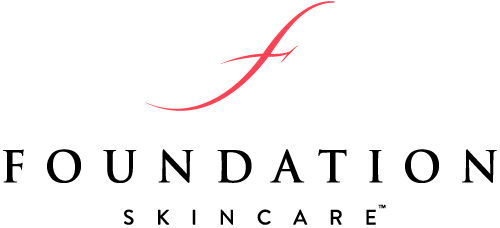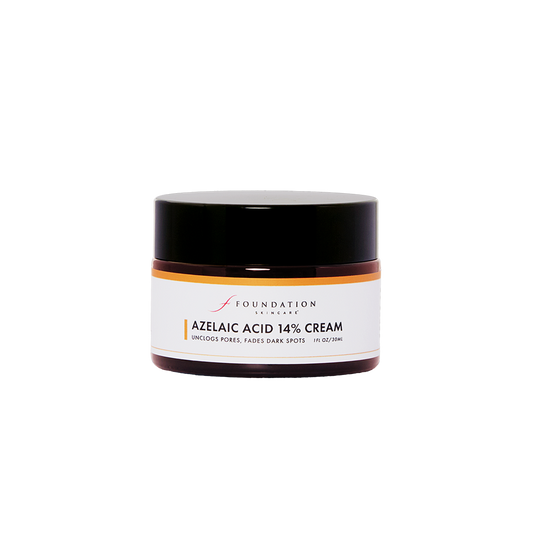In 1995, azelaic acid was approved by the FDA for the treatment of mild-to-moderate inflammatory acne.1Since then, more benefits have emerged about this incredibly versatile and potent skincare ingredient. It can even your skin tone, reduce rosacea flare ups, shrink pores, and even minimize the appearance of wrinkles.
Read on to discover more azelaic acid benefits, how Foundation Skincare’s Azelaic Acid 14% Cream compares to other popular products like Paula’s Choice Azelaic Acid, and how to choose the best product for your needs.
What is Azelaic Acid and Why is It Important?
Azelaic Acid is a naturally-occurring dicarboxylic acid produced by yeast in certain grains as well as the beneficial yeast on our skin. Its versatility makes it a key ingredient in a regular skincare routine, whether you are targeting skin conditions like rosacea and acne or pigmentation disorders like melasma or hyperpigmentation. Azelaic acid has also shown to be helpful in reducing wrinkles and fine lines.
One reason azelaic acid is so useful in fighting acne is that it helps to inhibit the conversion of testosterone to DHT, which minimizes hormonal breakouts. It also blocks the production of pigment in skin cells to even out skin tone.
Here are some studies confirming azelaic acid’s efficacy:
- Acne: Case studies of adult females with acne have shown that azelaic acid offers an effective, well-tolerated treatment for acne due to its anti-inflammatory mechanism of action.2 Acne improved progressively over a period of six months of treatment. Other studies have found its results to be comparable to topical tretinoin, benzoyl peroxide, erythromycin and oral tetracycline.3
- Hyperpigmentation: Studies have also found azelaic acid to be comparable to topical hydroquinone in treating hyperpigmentation disorders like melasma.4 And in a study of facial hyperpigmentation in darker-skinned patients, azelaic acid was found to be an effective and well-tolerated treatment with significantly greater decreases in pigmentary intensity than the vehicle control.5
- Wrinkles and fine lines: Due to its antioxidant effects, azelaic acid fights free radicals that contribute to wrinkles, fine lines, and other signs of aging. Studies show that it is useful in improving skin texture, increasing skin elasticity and flexibility, and reducing wrinkles.6
Foundation Skincare’s Azelaic Acid
Foundation Skincare’s Azelaic Acid 14% Cream contains the highest concentration of azelaic acid available without a prescription at a potent 14%. With a moisturizing base, this medical-grade product is dermatologist formulated and chemist engineered to soothe and manage skin conditions like acne and hyperpigmentation without irritating or drying out the skin. It can also be easily layered with other skincare products like Niacinamide Lotion 10%, which contributes to DNA repair, and Hyaluronic Acid Lotion, which works as a magnet for skin hydration.
Even more, FS Azelaic Acid will not make your skin more sensitive to the sun like hydroquinone does, though you should always use sunscreen with SPF 30+ if going out into the sun.
What it Targets
FS Azelaic Acid targets the following skin conditions:
- Mild to moderate acne and rosacea
- Hyperpigmentation, including melasma, acne scars, brown spots, and sun damage
- Fine lines and wrinkles
- Dull skin
How to Apply It
FS Azelaic Acid should always be applied last in your skincare routine, but before sunscreen during your morning application. You can use it twice daily, but always use a pea-sized amount. With consistent application, you may see results within 30 days, specifically less redness and a softer texture. Best results may take up to three months with skin conditions visibly improved.
How to use:
- Cleanse skin with a mild cleanser and pat dry.
- Apply moisturizer or any other serums you may be using, such as niacinamide, vitamin C, or hyaluronic acid.
- Apply a thin layer of FS Azelaic Acid to your entire face as the last step in your skincare routine.
- Avoid using the product on your eyes, lips, and mouth.
- Follow up with sunscreen with an SPF of 30 or higher (in the day).
- Use once or twice daily depending on your skin type and condition.
Ingredients
Most azelaic acid prescriptions contain 15-20% azelaic acid, which tends to cause dryness and irritation, especially in sensitive skin. On the other hand, most over-the-counter formulas contain around 10% of the active ingredient, rendering them not as effective. FS Azelaic Acid is considered “medical-grade” due to its powerful 14% concentration, but it is formulated to be gentle enough for even the most sensitive skin.
The FS Azelaic Acid product also contains tocopheryl acetate, a form of vitamin E, which softens skin and protects cells from damage due to its antioxidant qualities. Vitamin E may also help reduce inflammation and redness.
Azelaic Acid 14% Cream
• Brightens skin, fades brown spots
• Unclogs pores, improves texture
Paula’s Choice Azelaic Acid
Like many other over-the-counter formulas, Paula’s Choice Azelaic Acid has a 10% concentration. It has a lightweight, oil-free texture with a cream-gel base. According to its manufacturers, it can be used alone or with a moisturizer to soften skin, calm redness, and fade an uneven skin tone. The formula also contains salicylic acid, which helps to exfoliate skin. Salicylic acid is generally recommended for oily or acne-prone skin; if you already have dry skin, this ingredient can further dry out skin and potentially lead to irritation.7
What it Targets
Paula’s Choice Azelaic Acid is said to target the following skin conditions:
- Uneven skin tone
- Clogged pores
- Redness and inflammation
- Post-acne marks
- Hyperpigmentation
How to Apply it
Paula’s Choice Azelaic Acid can be used alone or in combination with a moisturizer or serum, according to the company. They also claim that the product works immediately, with full results visible after 4-12 weeks of consistent daily use.
How to use:
- Cleanse skin.
- Apply toner and AHA or BHA exfoliant first.
- Apply azelaic acid to the face and neck alone or with an SPF-free moisturizer.
- Follow application with sunscreen (in the day).
- Use once or twice daily.
Ingredients
In addition to azelaic acid, the product contains salicylic acid, and plant extracts like adenosine, allantoin, licorice root, and Boerhavia diffusa root. These extracts are included to soothe skin and further correct an uneven skin tone.
Due to this product containing salicylic acid, it may not be suitable for those with a salicylate allergy.
Foundation Skincare Azelaic Acid vs Paula’s Choice
It’s safe to say that both FS Azelaic Acid and Paula’s Choice have promising qualities due to the comprehensive skin-boosting qualities of azelaic acid, ranging from fighting acne to reducing dark spots and wrinkles. However, FS Azelaic Acid contains a higher concentration of this active ingredient in a gentler formulation that will not dry out skin, making it a powerful addition to your skincare routine, with no prescription needed.
Let’s review their similarities and differences:
Similarities
- Both products contain azelaic acid.
- They target the same skin concerns.
- They can be used alone or paired with other serums.
- Both products have a cream base.
- They can be used twice daily.
Differences
- FS Azelaic Acid has a 14% concentration of the active ingredient; Paula’s Choice Azelaic Acid has a 10% concentration.
- Paula’s Choice Azelaic Acid also contains salicylic acid, which may not be suitable for those with a salicylate allergy or those with dry skin.
- FS Azelaic Acid contains vitamin E, which further softens skin and protects from cell damage.
Choosing the Best Azelaic Acid for You
When it comes to choosing the best azelaic acid for your needs, consider what the research says on the importance of potency. Dermatologists explain that higher concentrations of the active ingredient are more effective and comparable to prescription strength while over-the-counter formulations of 10% or lower may or may not be effective.
While Paula’s Choice Azelaic Acid may be an inexpensive option for your skincare regime, if you’re looking for a medical-grade product without having to visit the dermatologist, then you may prefer FS Azelaic Acid.
And if your main concern is hyperpigmentation, pair this product with Foundation Skincare’s Pigmentation Defense, a supplement containing antioxidants, vitamins, and herbs proven to reduce hyperpigmentation and encourage healthy skin turnover.
View more products in the Foundation Skincare collection and find more tips on how to build the ultimate skincare routine in the FS Journal.
References:
-
https://www.ahdbonline.com/issues/2016/march-2016-vol-9-seventh-annual-payers-guide/2134-finacia-foam-azelaic-acid-the-newest-topical-treatment-fda-approved-for-the-treatment-of-inflammatory-lesions-of-rosacea
-
https://www.ncbi.nlm.nih.gov/pmc/articles/PMC9975535/
-
https://pubmed.ncbi.nlm.nih.gov/1712709/
-
https://www.sciencedirect.com/science/article/abs/pii/S0149291898800763
-
https://pubmed.ncbi.nlm.nih.gov/36056802/
-
https://www.healthline.com/health/skin/salicylic-acid-for-acne
-
https://www.forbes.com/sites/nomanazish/2021/12/31/should-you-be-using-azelaic-acid-heres-what-the-dermatologists-say/?sh=46f076d5624f





